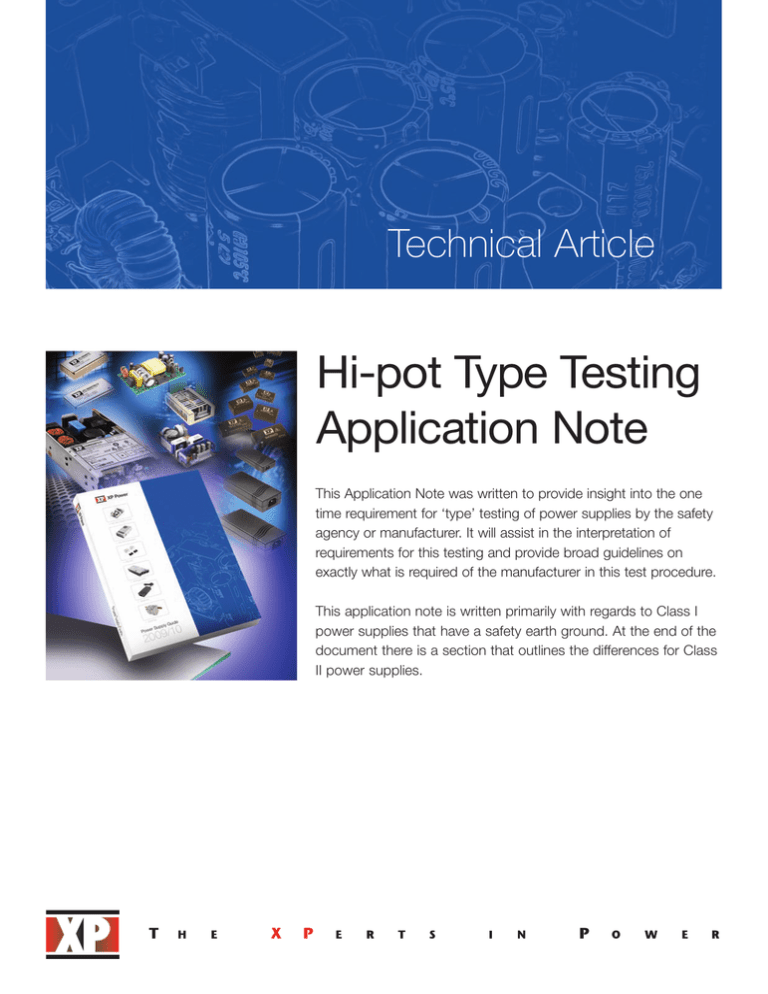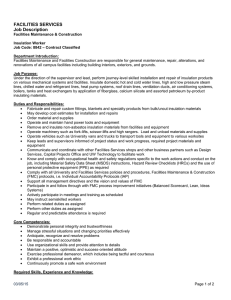Hi-pot Type Testing Application Note
advertisement

Technical Article Hi-pot Type Testing Application Note This Application Note was written to provide insight into the one time requirement for ‘type’ testing of power supplies by the safety agency or manufacturer. It will assist in the interpretation of requirements for this testing and provide broad guidelines on exactly what is required of the manufacturer in this test procedure. This application note is written primarily with regards to Class I power supplies that have a safety earth ground. At the end of the document there is a section that outlines the differences for Class II power supplies. xppower.com Insulation Types Figure 1 below represents a typical power supply from the standpoint of insulation systems. C1 C3 R • Between Primary and Secondary, reinforced insulation is required Primary Secondary • Between Primary and Chassis Ground, basic insulation is required C2 • Between Secondary and Chassis Ground, operational insulation is required R – Location of typical Reinforced Insulation Grounded Chassis B C4 O B – Location of typical Basic Insulation Figure 1: Typical Power Supply Insulation O – Location of typical Operational Insulation Safety Agency Testing Testing requirements are categorized into two groups: • Type Testing (Design Verification) • Production Testing Type Tests These are the tests which are done by the safety agencies, and are intended to prove that the construction of the power supply meets the requirements dictated by the relevant safety standard. For IEC/UL60950-1 (ITE) and UL60601-1 (Medical) the requirements are as follows: 60950-1 60601-1 Primary to Secondary 3000 VAC, or the equivalent DC voltage Primary to Grounded chassis 1500 VAC, or the equivalent DC voltage Secondary to Grounded chassis No requirement provided the secondary voltage is less than 42.4 VAC or 60 VDC Primary to Secondary 4000 VAC, or the equivalent DC voltage Primary to Grounded chassis 1500 VAC, or the equivalent DC voltage Secondary to Grounded chassis No requirement provided the secondary voltage is less than 42.4 VAC or 60 VDC Figure 2: Insulation Type Testing Levels Note: Information for IEC/UL609501 is based on 250 Vrms as specified in 2nd Edition, Table 5B. Information for IEC/UL606011 is from 2nd Edition Table V and is based on a 250 Vrms working voltage. Production Testing These tests are done as part of the manufacturing process and are intended to ensure integrity of safety critical insulation. Production line testing will be conducted on Basic insulation and on Reinforced insulation during manufacture. Reinforced (primary to secondary) insulation cannot be tested without over-stressing basic insulation on the end product. (Note: see UL60950-1, C5.2.2 or UL60601-1 2nd Edition Section 20.4 or IEC60601-1 3rd Edition Section 8.8.3 for more information.) Because of this the agencies allow manufacturers to test reinforced insulation separately. This means they are allowed to test transformers and other primary to secondary isolation barriers separately before components are incorporated into the product. 2 xppower.com *g) Care is taken that the voltage applied to a REINFORCED INSULATION does not overstress BASIC INSULATION OR SUPPLEMENTARY INSULATION in the EQUIPMENT Figure 3: UL60601-1 2nd Edition Section 20.4 Only primary to chassis ground (basic insulation) testing is required in production on the final assembly prior to shipping each product. Type Test (Design Verification Test) Often times a customer or safety agency engineer wants to verify the type tests on a finished product in the field. This can be done; however, special precautions must be taken to ensure a correct result is achieved. If basic (primary to chassis ground) insulation is to be verified then no special considerations need to be taken. Simply apply a 1500 VAC voltage from Primary AC input to chassis ground. However, if a primary to secondary insulation is to be verified special precautions need to be taken. Because only basic insulation exists between primary and chassis ground and only operational insulation exists between secondary and chassis ground, any attempt to apply 3000 VAC directly from primary to secondary on the finished product will over stress the primary to chassis ground and secondary to chassis insulation resulting in a failure. Remove C3 Primary Secondary To properly test reinforced insulation the power supply needs to be removed from the chassis. In addition, all paths to chassis ground, as far as practical, need to be removed so as not to over-stress basic and operational insulation during the test. C2 Grounded Chassis This usually entails removal of all Y-capacitors and gas discharge tubes and will need interaction with XP Power Engineering to ensure the correct disassembly. (See Figure 4, right) Remove Chassis R C1 B C4 Remove O Figure 4: Power Supply disassembly may be required for type tesing Sub-clause 20.4 j) Components designed to limit the voltage which may be destroyed by power dissipation during the dielectric strength test may be removed when the test is made. Figure 5: UL60601-1 2nd Edition Section 20.4 Rationale Unfortunately on some products not all paths can be removed. The reason for this is that some printed circuit boards have ground barriers or grounded traces laying between primary and secondary circuitry. Although ‘creepage and clearance’ requirements are met as specified in the safety standards, these traces, due to proximity, make up small capacitive dividers between secondary traces, floating ground traces and live primary traces. In some instances when applying the primary to secondary hi-pot voltage, some arcing will be observed on the printed circuit boards. In all cases this arcing has been limited to the secondary to grounded trace locations. In some instances this arcing can cause component failure, rendering the power supply inoperable. This is a breakdown of operational insulation (secondary to chassis ground) only. It does not indicate a failure of primary to secondary insulation that is the focus of the test. Provided this ‘fails’ in a safe manner, the test is considered successful for safety purposes. Differences for Class II Power Supplies The previous sections of this document all dealt with power supplies that were of Class I and so had a safety earth ground. Because of this they required hi-pot testing from primary to ground. In the case of Class II power supplies there is no safety ground and so there is no need, nor ability, to test from primary to chassis. Because of the lack of any grounding we also do not have to worry about over stressing any components from the primary to ground side or from the output to ground side. The user is able to simply test from the input to the output on the power supply at 3000 VAC (or 4121 VDC) for ITE devices or 4000 VAC (5656 VDC) for medical devices to verify the insulation in the supply. For further technical information about this article, please contact your local XP Power representative. 3 www.xppower.com North American HQ Asian HQ XP Power 990 Benecia Avenue, Sunnyvale, CA 94085 Phone : +1 (408) 732-7777 Fax : +1 (408) 732-2002 Email : nasales@xppower.com XP Power 401 Commonwealth Drive, Haw Par Technocentre, Lobby B, #02-02, Singapore 149598 Phone : +65 6411 6900 Fax : +65 6741 8730 Email : apsales@xppower.com Web : www.xppowerchina.com / www.xppower.com North American Sales Offices Toll Free.........................+1 (800) 253-0490 Central Region...............+1 (972) 578-1530 Eastern Region ............+1 (973) 658-8001 Western Region.............+1 (408) 732-7777 Asian Sales Offices Shanghai ....................... +86 21 51388389 Singapore.......................... +65 6411 6902 European HQ German HQ Distributors XP Power Horseshoe Park, Pangbourne, Berkshire, RG8 7JW, UK Phone : +44 (0)118 984 5515 Fax : +44 (0)118 984 3423 Email : eusales@xppower.com XP Power Auf der Höhe 2, D-28357 Bremen, Germany Phone : +49 (0)421 63 93 3 0 Fax : +49 (0)421 63 93 3 10 Email : desales@xppower.com Australia ..........................+61 2 9809 5022 Balkans ...........................+386 1 583 7930 Czech Rep. ...................+420 235 366 129 Czech Rep. ...................+420 539 050 630 Estonia ................................+372 6228866 Greece ..........................+30 210 240 1961 Israel ................................+972 9 7498777 Japan ..............................+81 48 864 7733 Korea ..............................+82 31 422 8882 Latvia ................................+371 67501005 Lithuania...........................+370 5 2652683 Poland..............................+48 22 8627500 Portugal..........................+34 93 263 33 54 Russia ...........................+7 (495)234 0636 Russia ...........................+7 (812)325 5115 South Africa.....................+27 11 453 1910 Spain..............................+34 93 263 33 54 Taiwan ..............................+886 3 3559642 Turkey ...........................+90 212 465 7199 European Sales Offices Austria ........................+41 (0)56 448 90 80 Belgium .....................+33 (0)1 45 12 31 15 Denmark ..........................+45 43 42 38 33 Finland........................+46 (0)8 555 367 01 France ......................+33 (0)1 45 12 31 15 Germany....................+49 (0)421 63 93 3 0 Italy ................................+39 039 2876027 Netherlands ...............+49 (0)421 63 93 3 0 Norway.............................+47 63 94 60 18 Sweden ..................... +46 (0)8 555 367 00 Switzerland ................ +41 (0)56 448 90 80 United Kingdom.........+44 (0)118 984 5515 Amtex Elbacomp Vums Powerprag Koala Elektronik Elgerta ADEM Electronics Appletec Bellnix Hanpower Caro Elgerta Gamma Venco Prosoft Gamma Vepac Venco Fullerton Power EMPA Global Catalog Distributors Americas ........................................Newark Europe & Asia...................................Farnell China ............................Premier Electronics newark.com farnell.com premierelectronics.com.cn 25-Feb-10




